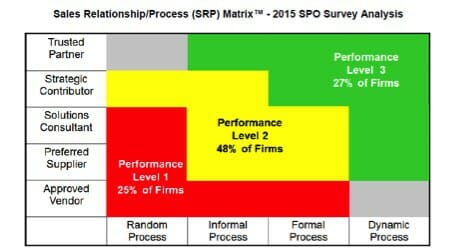If you had the opportunity to survey a wide range of top sales organizations and the top performers that support their winning sales teams, you’d find some steady trends. Top organizations are organized, disciplined, and results oriented. They approach business in a structured fashion and develop and support processes that help employees maintain high standards. Top employees, in turn, excel at what they do, and thrive in an environment that recognizes their talents while holding them accountable for success.
Two recent surveys provide deep insight into the characteristics of top performing sales organizations. Steve W. Martin provides an overview of his recent study on high-performing sales organizations in the Harvard Business Review, and two colleagues at CSO Insights, Jim Dickie and Barry Trailer, review their research findings in a white paper titled The Anatomy of a World-Class Sales Organization 2015. Each paper has interesting and original insights, but there is common ground: [bctt tweet=”Leading sales organizations have a sound structure, strong processes, and strict accountability measures for their salespeople.”
Top companies maintain a strong structure
Martin’s study was a 42-part survey with 786 sales professional from various levels of achievement within their organizations and from various industries. He found that 50% of study participants from high-performing sales organizations, those where annual revenues increased significantly year-over-year, responded they had sales processes that were closely monitored, strictly enforced or automated, compared to just 28% from underperforming sales organizations.
Dickie and Trailer’s research focused on data pulled from 1,000 participating companies. The study, like Martin’s, found that structure was critical to building and maintaining a world-class sales organization. Once top talent is identified and hired, the author, like us, stresses the importance of providing sales reps with training and the right sales tools in order to help these top performers optimize their efficiency.
Both studies also recognized – in slightly different ways – how important it is for departments outside of sales to participate in helping the sales team achieve success, particularly when it comes to adapting to market fluctuations, or helping to train managers on how to better adapt to changing times. Here are a few ways HR and the sales department can work more closely.
Process-driven organizations achieve more market share
Optimizing sales processes by maintaining a structured approach for engaging and working with clients helps companies outsell their competitors, note Dickie and Trailer. The CSO research took a deep dive into process, showing four levels of the sales process. Level 1 is a random process, Level 2 is an informal process that’s loosely defined but not monitored. Level 3 is a formal process that is reviewed and measured, and Level 4 is a dynamic process that goes through cycles of feedback and modification. As companies moved up through the levels of process, Dickie and Trailer found, their performance improved.
Matching sales process with the various types of relationships salespeople have with clients, (approved vendor, preferred supplier, solutions consultant, strategic contributor, and trusted partner) the CSO research team created a matrix that shows how process drives achievement in sales:
When a process is in place, is followed by everyone, and leadership is able to adjust the processes as needed to account for market fluctuations or other factors inside or outside of the organization, salespeople can focus on selling. Why? Because the sales team understands what’s expected of them, work more efficiently and accomplish more. Similarly, Martin’s study found that 48 percent of the participants from underperforming sales organizations indicated they had non-existent or informal structured sales processes compared to only 29% from high performing sales organizations.
Accountability leads to higher performance
Martin found that high-performing sales organizations hold their team members to a higher level of accountability. “High-performing sales organizations are not afraid to aggressively raise year-over-year annual quotas,” notes Martin, adding that 75 percent of high-performing sales organizations raised 2014 annual quotas more than 10 percent over the previous year.
High expectations and quotas should also reflect in high rewards. Dickie and Trailer note that successful salespeople at top performing firms should have compensation programs that are more enhanced, and Martin, like us, advocates a strong bonus and commission structure.
Accountability is arguably the most powerful tool for getting reps to perform and Martin notes that [bctt tweet=”high-performing sales organizations are typically quicker to terminate underperforming salespeople”] – 18 percent of high-performing sales organizations indicated that salespeople will be terminated for poor performance after one quarter. This contrasted dramatically with average companies – only 2% reported they would terminate underperforming employees after one quarter.
Overall, these researchers found new ways to verify assumptions that many sales leaders may have been making all along. “The results from this study,” notes Martin, “quantify that the best sales organizations have strong leaders who exercise control, monitor team performance, and establish internal processes that all team members must abide by.”
Staying at the top requires a mix of talent, structure, process, and people that’s very difficult to balance correctly. The researchers suggest companies work hard to make the most of the tools available to them – including a wide range of sales pipeline and CRM software which can greatly support and enhance performance and growth. “It is not easy. It is not fast. It is not cheap,” write Dickie and Trainer, noting with a bit of a warning that, “It is not optional.”
Two recent surveys provide deep insight into the characteristics of top performing sales organizations. Steve W. Martin provides an overview of his recent study on high-performing sales organizations in the Harvard Business Review, and two colleagues at CSO Insights, Jim Dickie and Barry Trailer, review their research findings in a white paper titled The Anatomy of a World-Class Sales Organization 2015. Each paper has interesting and original insights, but there is common ground: [bctt tweet=”Leading sales organizations have a sound structure, strong processes, and strict accountability measures for their salespeople.”]
Top companies maintain a strong structure
Martin’s study was a 42-part survey with 786 sales professional from various levels of achievement within their organizations and from various industries. He found that 50% of study participants from high-performing sales organizations, those where annual revenues increased significantly year-over-year, responded they had sales processes that were closely monitored, strictly enforced or automated, compared to just 28% from underperforming sales organizations.
Dickie and Trailer’s research focused on data pulled from 1,000 participating companies. The study, like Martin’s, found that structure was critical to building and maintaining a world-class sales organization. Once top talent is identified and hired, the author, like us, stresses the importance of providing sales reps with training and the right sales tools in order to help these top performers optimize their efficiency.
Both studies also recognized – in slightly different ways – how important it is for departments outside of sales to participate in helping the sales team achieve success, particularly when it comes to adapting to market fluctuations, or helping to train managers on how to better adapt to changing times. Here are a few ways HR and the sales department can work more closely.
Process-driven organizations achieve more market share
Optimizing sales processes by maintaining a structured approach for engaging and working with clients helps companies outsell their competitors, note Dickie and Trailer. The CSO research took a deep dive into process, showing four levels of the sales process. Level 1 is a random process, Level 2 is an informal process that’s loosely defined but not monitored. Level 3 is a formal process that is reviewed and measured, and Level 4 is a dynamic process that goes through cycles of feedback and modification. As companies moved up through the levels of process, Dickie and Trailer found, their performance improved.
Matching sales process with the various types of relationships salespeople have with clients, (approved vendor, preferred supplier, solutions consultant, strategic contributor, and trusted partner) the CSO research team created a matrix that shows how process drives achievement in sales:
” alt=”Relationship Sales Process” width=”452″ height=”251″ sizes=”(max-width: 452px) 100vw, 452px” data-src=”https://www.peaksalesrecruiting.com/wp-content/uploads/2024/01/Sales-Relationship-Process.jpg” data-srcset=”https://www.peaksalesrecruiting.com/wp-content/uploads/2024/01/Sales-Relationship-Process.jpg 452w, https://www.peaksalesrecruiting.com/wp-content/uploads/2024/01/1_Sales-Relationship-Process-300×167.jpg 300w” />
Source: The Anatomy of a World-Class Sales Organization – 2015, CSO Insights.
When a process is in place, is followed by everyone, and leadership is able to adjust the processes as needed to account for market fluctuations or other factors inside or outside of the organization, salespeople can focus on selling. Why? Because the sales team understands what’s expected of them, work more efficiently and accomplish more. Similarly, Martin’s study found that 48 percent of the participants from underperforming sales organizations indicated they had non-existent or informal structured sales processes compared to only 29% from high performing sales organizations.
Accountability leads to higher performance
Martin found that high-performing sales organizations hold their team members to a higher level of accountability. “High-performing sales organizations are not afraid to aggressively raise year-over-year annual quotas,” notes Martin, adding that 75 percent of high-performing sales organizations raised 2014 annual quotas more than 10 percent over the previous year.
High expectations and quotas should also reflect in high rewards. Dickie and Trailer note that successful salespeople at top performing firms should have compensation programs that are more enhanced, and Martin, like us, advocates a strong bonus and commission structure.
Accountability is arguably the most powerful tool for getting reps to perform and Martin notes that [bctt tweet=”high-performing sales organizations are typically quicker to terminate underperforming salespeople”] – 18 percent of high-performing sales organizations indicated that salespeople will be terminated for poor performance after one quarter. This contrasted dramatically with average companies – only 2% reported they would terminate underperforming employees after one quarter.
Overall, these researchers found new ways to verify assumptions that many sales leaders may have been making all along. “The results from this study,” notes Martin, “quantify that the best sales organizations have strong leaders who exercise control, monitor team performance, and establish internal processes that all team members must abide by.”
Staying at the top requires a mix of talent, structure, process, and people that’s very difficult to balance correctly. The researchers suggest companies work hard to make the most of the tools available to them – including a wide range of sales pipeline and CRM software which can greatly support and enhance performance and growth. “It is not easy. It is not fast. It is not cheap,” write Dickie and Trainer, noting with a bit of a warning that, “It is not optional.”
relpost-thumb-wrapper
Related posts
close relpost-thumb-wrapper
Eliot Burdett
He co-authored Sales Recruiting 2.0, How to Find Top Performing Sales People, Fast and provides regular insights on sales team management and hiring on the Peak Sales Recruiting Blog.
Latest posts by Eliot Burdett (see all)
- 20 Of Our Favorite Books About Sales Management and Sales Leadership – October 20, 2023
- How To Make Progress On Your Sales Goal Without A Sales Leader – September 15, 2021
- Augment Your Recruiting Strategy During “The Great Resignation” – July 26, 2021






